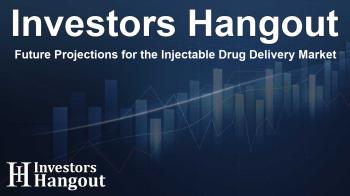Future Projections for the Injectable Drug Delivery Market

Exploring Growth in the Injectable Drug Delivery Devices Market
The injectable drug delivery devices market is experiencing remarkable growth with projections to reach approximately USD 1,217 billion by 2034, according to recent findings from Statifacts. This expected increase from USD 565 billion in 2025 represents a compound annual growth rate (CAGR) of 8.9% over the forecast period. The driving factors behind this growth encompass supportive government policies, the escalating preference for self-administration of medications, and advancements in technology such as connected devices and smart injectors.
Technological Innovations Shaping the Market
Recent innovations in injectable drug delivery systems have revolutionized how medications are administered. Devices such as smart autoinjectors and needle-free injectors are gaining traction. These advancements enhance patient comfort and streamline the administration process, particularly for chronic conditions such as diabetes and cardiovascular diseases. The growing acceptance of modern technology in healthcare settings further propels market growth.
The Role of Biologics
Biologics are a significant part of the injectable market, providing effective treatments for a range of medical conditions. Vaccines, for instance, are a prominent category of biologics that not only prevent diseases but also contribute to extending life expectancy globally. In fact, vaccines have been known to save millions of lives through effective disease control. Continuous development in biotechnology ensures that injectable therapies remain at the forefront of medical advancements.
Market Demographics and Trends
Key trends indicate that North America is at the forefront of market share, holding approximately 40.5% in 2024. However, the Asia-Pacific region is projected to experience the fastest growth during the forecast period. This growth is attributed to rising healthcare expenditures, an increasing geriatric population, and higher demands for self-injection devices.
Challenges Facing Injectable Drug Delivery Devices
Despite strong growth prospects, the injectable drug delivery devices market faces significant challenges. Ensuring the sterility of injectable products is crucial, as contamination can lead to severe health implications such as infections or worse. Moreover, needlestick injuries pose health risks, emphasizing the importance of user-friendly device designs that minimize contact risks.
Implications of Needle Phobia
Needle phobia can significantly impact patient compliance with injectable therapies. Many individuals experience anxiety at the prospect of injections, which can deter them from pursuing necessary treatments. Addressing this issue through the development of innovative, less intimidating delivery methods is essential for enhancing patient psychological comfort.
Market Scope and Segment Analysis
The market encompasses various product segments, with formulations currently holding the majority share. Devices such as prefilled syringes and on-body delivery systems are anticipated to witness significant growth. Furthermore, the oncology segment is emerging as a vital area within the market, largely due to increased cancer prevalence influenced by factors such as obesity and environmental pollutants.
Strategic Business Developments
Several prominent companies are driving the injectable market forward. Notable industry players include Baxter, BD (Becton, Dickinson, and Company), and Eli Lilly and Company. These organizations continuously invest in research and development to innovate and introduce new products that meet the evolving needs of healthcare providers and patients.
Market Predictions for the Future
Looking ahead, the injectable drug delivery market is set for robust growth. Analysts predict that advancements in technology, along with increasing healthcare demands, will continue to drive innovations in this field. New opportunities will emerge from the ongoing research into biologics and other advanced therapeutic methods, making this an exciting time for stakeholders in the medical device arena.
Frequently Asked Questions
What is the projected market size of injectable drug delivery devices by 2034?
The market is projected to reach approximately USD 1,217 billion by 2034.
What factors are driving the growth of this market?
Key growth drivers include government policies supporting self-administration, advancements in technology, and the rising prevalence of chronic diseases.
How does the market differ between various regions?
North America currently leads the market; however, the Asia-Pacific region is anticipated to grow the fastest due to increasing healthcare demands and an aging population.
What challenges do injectables face in the market?
The main challenges include ensuring sterility, managing needlestick injuries, and overcoming patient anxiety related to injections.
Which companies are key players in the injectable drug delivery market?
Key players include Baxter, BD, Eli Lilly and Company, and Terumo Corporation, all of which are focused on innovation and development in the field.
About The Author
Contact Thomas Cooper privately here. Or send an email with ATTN: Thomas Cooper as the subject to contact@investorshangout.com.
About Investors Hangout
Investors Hangout is a leading online stock forum for financial discussion and learning, offering a wide range of free tools and resources. It draws in traders of all levels, who exchange market knowledge, investigate trading tactics, and keep an eye on industry developments in real time. Featuring financial articles, stock message boards, quotes, charts, company profiles, and live news updates. Through cooperative learning and a wealth of informational resources, it helps users from novices creating their first portfolios to experts honing their techniques. Join Investors Hangout today: https://investorshangout.com/
The content of this article is based on factual, publicly available information and does not represent legal, financial, or investment advice. Investors Hangout does not offer financial advice, and the author is not a licensed financial advisor. Consult a qualified advisor before making any financial or investment decisions based on this article. This article should not be considered advice to purchase, sell, or hold any securities or other investments. If any of the material provided here is inaccurate, please contact us for corrections.

